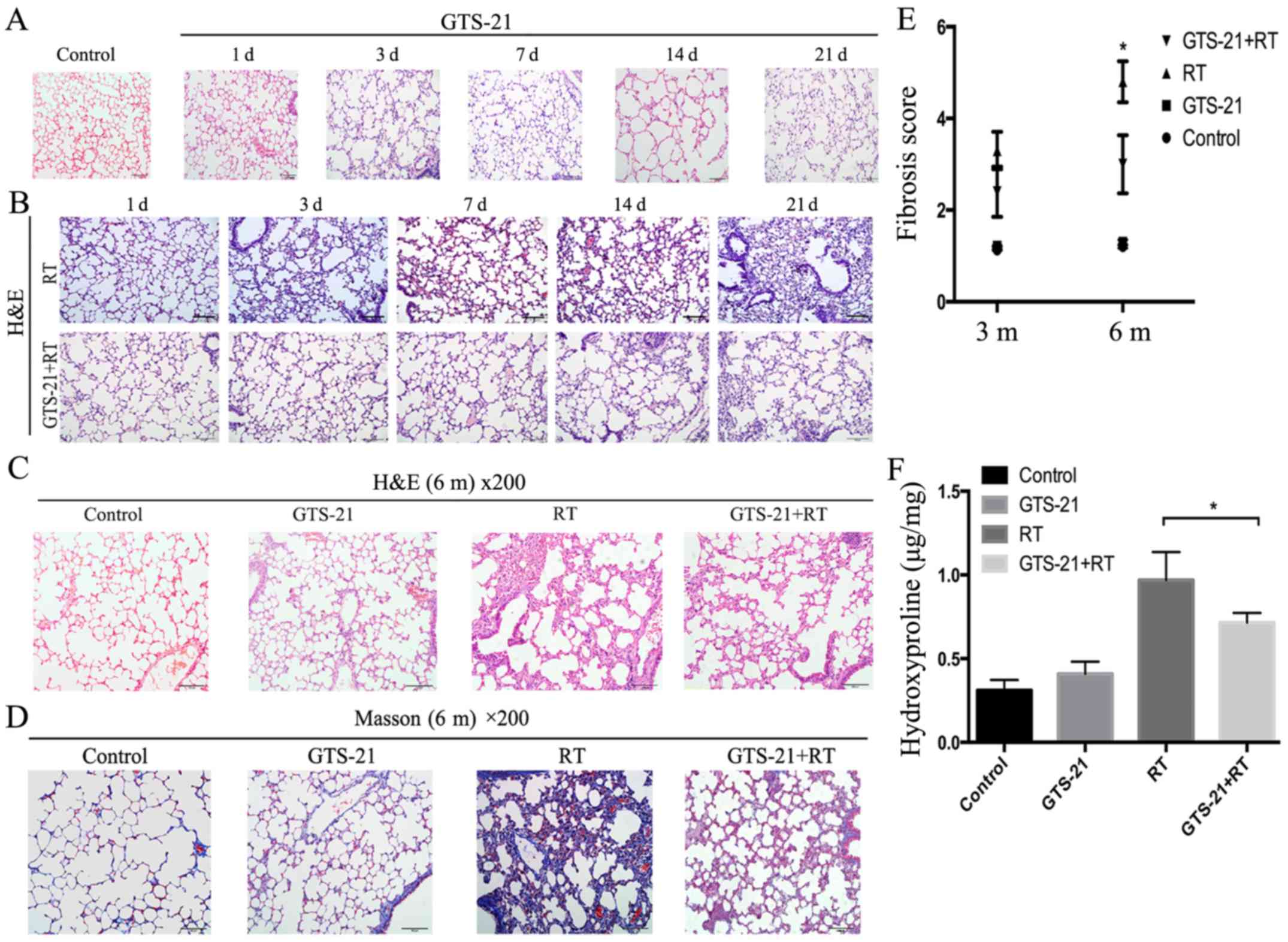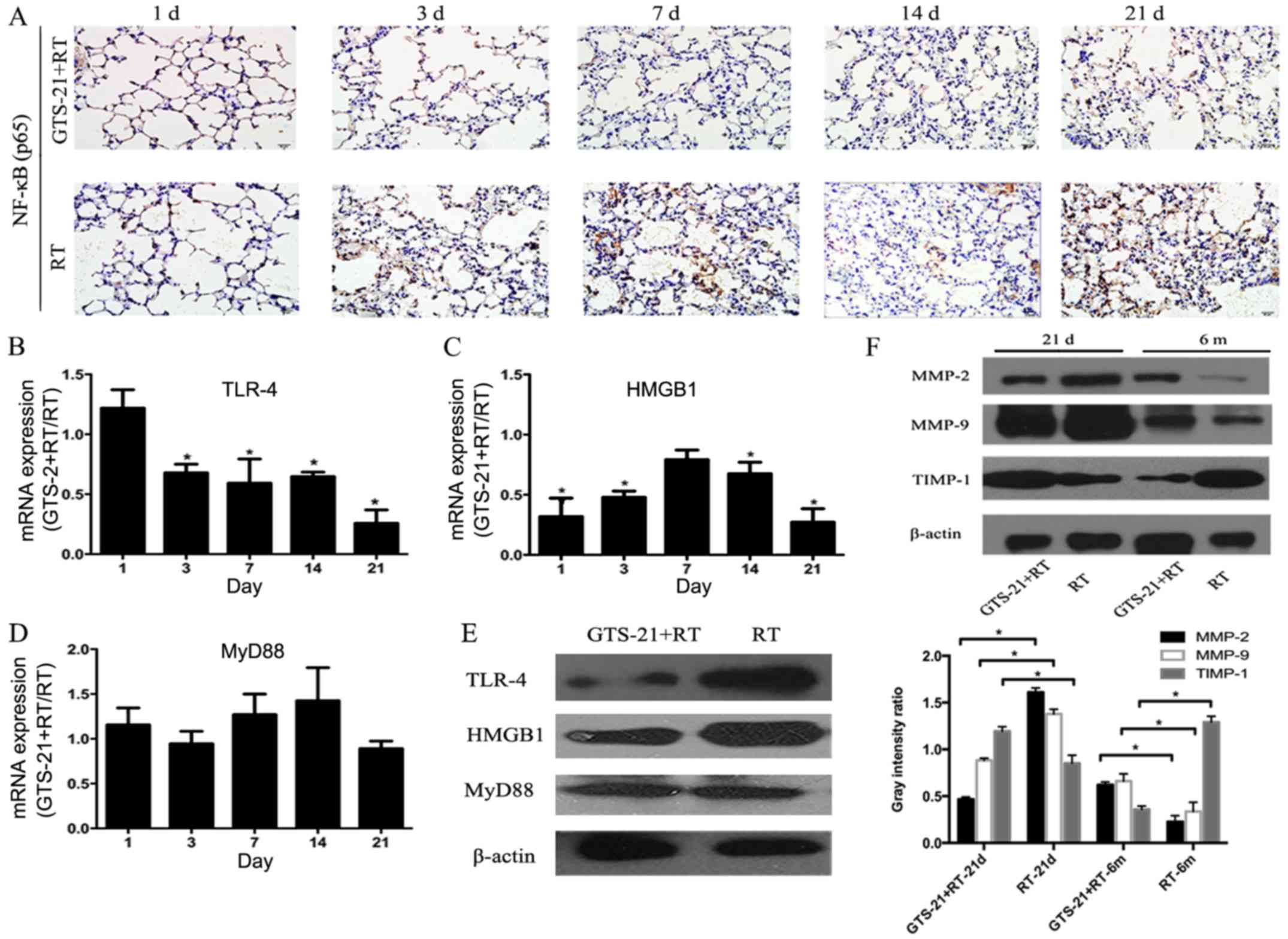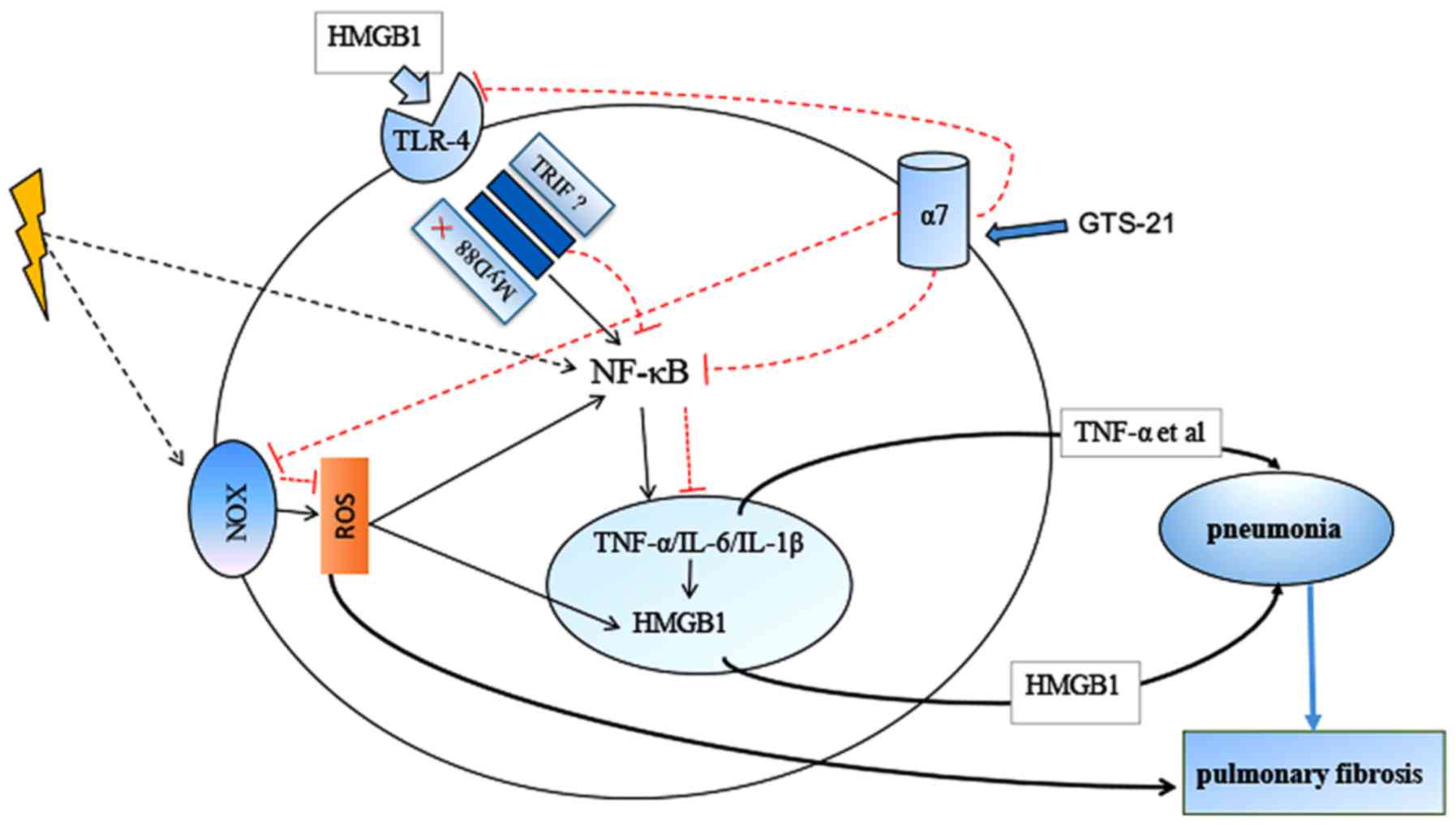|
1
|
Das SK, Zhou S, Zhang J, Yin FF, Dewhirst
MW and Marks LB: Predicting lung radiotherapy-induced pneumonitis
using a model combining parametric Lyman probit with nonparametric
decision trees. Int J Radiat Oncol Biol Phys. 68:1212–1221. 2007.
View Article : Google Scholar : PubMed/NCBI
|
|
2
|
Pahl HL: Activators and target genes of
Rel/NF-kappaB transcription factors. Oncogene. 18:6853–6866. 1999.
View Article : Google Scholar : PubMed/NCBI
|
|
3
|
Iademarco MF, McQuillan JJ, Rosen GD and
Dean DC: Characterization of the promoter for vascular cell
adhesion molecule-1 (VCAM-1). J Biol Chem. 267:16323–16329.
1992.PubMed/NCBI
|
|
4
|
Liu GD, Xia L, Zhu JW, Ou S, Li MX, He Y,
Luo W, Li J, Zhou Q, Yang XQ, et al: Genistein alleviates
radiation-induced pneumonitis by depressing Ape1/Ref-1 expression
to down-regulate inflammatory cytokines. Cell Biochem Biophys.
69:725–733. 2014. View Article : Google Scholar : PubMed/NCBI
|
|
5
|
Wajant H, Pfizenmaier K and Scheurich P:
Tumor necrosis factor signaling. Cell Death Differ. 10:45–65. 2003.
View Article : Google Scholar : PubMed/NCBI
|
|
6
|
Javaid K, Rahman A, Anwar KN, Frey RS,
Minshall RD and Malik AB: Tumor necrosis factor-alpha induces
early-onset endothelial adhesivity by protein kinase
Czeta-dependent activation of intercellular adhesion molecule-1.
Circ Res. 92:1089–1097. 2003. View Article : Google Scholar : PubMed/NCBI
|
|
7
|
Sullivan DE, Ferris M, Pociask D and Brody
AR: Tumor necrosis factor-alpha induces transforming growth
factor-beta1 expression in lung fibroblasts through the
extracellular signal-regulated kinase pathway. Am J Respir Cell Mol
Biol. 32:342–349. 2005. View Article : Google Scholar : PubMed/NCBI
|
|
8
|
Chen Y, Williams J, Ding I, Hernady E, Liu
W, Smudzin T, Finkelstein JN, Rubin P and Okunieff P: Radiation
pneumonitis and early circulatory cytokine markers. Semin Radiat
Oncol. 12 1 Suppl 1:S26–S33. 2002. View Article : Google Scholar
|
|
9
|
Hosoi Y, Miyachi H, Matsumoto Y, Enomoto
A, Nakagawa K, Suzuki N and Ono T: Induction of interleukin-1beta
and interleukin-6 mRNA by low doses of ionizing radiation in
macrophages. Int J Cancer. 96:270–276. 2001. View Article : Google Scholar : PubMed/NCBI
|
|
10
|
Johnston CJ, Williams JP, Elder A, Hernady
E and Finkelstein JN: Inflammatory cell recruitment following
thoracic irradiation. Exp Lung Res. 30:369–382. 2004. View Article : Google Scholar : PubMed/NCBI
|
|
11
|
Hellweg CE: The Nuclear Factor kappaB
pathway: A link to the immune system in the radiation response.
Cancer Lett. 368:275–289. 2005. View Article : Google Scholar
|
|
12
|
Chishti AA, Baumstark-Khan C, Koch K,
Kolanus W, Feles S, Konda B, Azhar A, Spitta LF, Henschenmacher B,
Diegeler S, et al: Linear energy transfer modulates
radiation-induced NF-kappa B activation and expression of its
downstream target genes. Radiat Res. 189:354–370. 2018. View Article : Google Scholar : PubMed/NCBI
|
|
13
|
Pradere JP, Dapito DH and Schwabe RF: The
Yin and Yang of Toll-like receptors in cancer. Oncogene.
33:3485–3495. 2014. View Article : Google Scholar : PubMed/NCBI
|
|
14
|
Yang K, Palm J, Konig J, Seeland U,
Rosenkranz S, Feiden W, Rübe C and Rübe CE:
Matrix-Metallo-Proteinases and their tissue inhibitors in
radiation-induced lung injury. Int J Radiat Biol. 83:665–676. 2007.
View Article : Google Scholar : PubMed/NCBI
|
|
15
|
Masamune A, Watanabe T, Kikuta K, Satoh K
and Shimosegawa T: NADPH oxidase plays a crucial role in the
activation of pancreatic stellate cells. Am J Physiol Gastrointest
Liver Physiol. 294:G99–G108. 2008. View Article : Google Scholar : PubMed/NCBI
|
|
16
|
Stas S, Whaley-Connell A, Habibi J, Appesh
L, Hayden MR, Karuparthi PR, Qazi M, Morris EM, Cooper SA, Link CD,
et al: Mineralocorticoid receptor blockade attenuates chronic
overexpression of the renin-angiotensin-aldosterone system
stimulation of reduced nicotinamide adenine dinucleotide phosphate
oxidase and cardiac remodeling. Endocrinology. 148:3773–3780. 2007.
View Article : Google Scholar : PubMed/NCBI
|
|
17
|
Hecker L, Vittal R, Jones T, Jagirdar R,
Luckhardt TR, Horowitz JC, Pennathur S, Martinez FJ and Thannickal
VJ: NADPH oxidase-4 mediates myofibroblast activation and
fibrogenic responses to lung injury. Nat Med. 15:1077–1081. 2009.
View Article : Google Scholar : PubMed/NCBI
|
|
18
|
Rabbani ZN, Mi J, Zhang Y, Delong M,
Jackson IL, Fleckenstein K, Salahuddin FK, Zhang X, Clary B,
Anscher MS and Vujaskovic Z: Hypoxia inducible factor 1alpha
signaling in fractionated radiation-induced lung injury: Role of
oxidative stress and tissue hypoxia. Radiat Res. 173:165–174. 2010.
View Article : Google Scholar : PubMed/NCBI
|
|
19
|
Mehta V: Radiation pneumonitis and
pulmonary fibrosis in non-small-cell lung cancer: Pulmonary
function, prediction, and prevention. Int J Radiat Oncol Biol Phys.
63:5–24. 2005. View Article : Google Scholar : PubMed/NCBI
|
|
20
|
Koopman FA, Schuurman PR, Vervoordeldonk
MJ and Tak PP: Vagus nerve stimulation: A new bioelectronics
approach to treat rheumatoid arthritis? Best Pract Res Clin
Rheumatol. 28:625–635. 2014. View Article : Google Scholar : PubMed/NCBI
|
|
21
|
Kox M, Pompe JC, Peters E, Vaneker M, van
der Laak JW, van der Hoeven JG, Scheffer GJ, Hoedemaekers CW and
Pickkers P: α7 nicotinic acetylcholine receptor agonist GTS-21
attenuates ventilator-induced tumour necrosis factor-alpha
production and lung injury. Br J Anaesth. 107:559–566. 2011.
View Article : Google Scholar : PubMed/NCBI
|
|
22
|
Chatterjee PK, Yeboah MM, Dowling O, Xue
X, Powell SR, Al-Abed Y and Metz CN: Nicotinic acetylcholine
receptor agonists attenuate septic acute kidney injury in mice by
suppressing inflammation and proteasome activity. PLoS One.
7:e353612012. View Article : Google Scholar : PubMed/NCBI
|
|
23
|
Sitapara RA, Antoine DJ, Sharma L, Patel
VS, Ashby CR Jr, Gorasiya S, Yang H, Zur M and Mantell LL: The α7
nicotinic acetylcholine receptor agonist GTS-21 improves bacterial
clearance in mice by restoring hyperoxia-compromised macrophage
function. Mol Med. 20:238–247. 2014. View Article : Google Scholar : PubMed/NCBI
|
|
24
|
World Medical Association General
Assembly: Guiding principles for research involving animals and
human beings. Am J Physiol Cell Physiol. 280:3p after R1913.
2002.
|
|
25
|
Chen J, Tian X, Mei Z, Wang Y, Yao Y,
Zhang S, Li X, Wang H, Zhang J and Xie C: The effect of the TLR9
ligand CpG-oligodeoxynucleotide on the protective immune response
to radiation-induced lung fibrosis in mice. Mol Immunol. 80:33–40.
2016. View Article : Google Scholar : PubMed/NCBI
|
|
26
|
Pavlov VA, Ochani M, Yang LH,
Gallowitsch-Puerta M, Ochani K, Lin X, Levi J, Parrish WR,
Rosas-Ballina M, Czura CJ, et al: Selective alpha7-nicotinic
acetylcholine receptor agonist GTS-21 improves survival in murine
endotoxemia and severe sepsis. Crit Care Med. 35:1139–44. 2007.
View Article : Google Scholar : PubMed/NCBI
|
|
27
|
Giebelen IA, van Westerloo DJ, LaRosa GJ,
de Vos AF and van der Poll T: Local stimulation of alpha7
cholinergic receptors inhibits LPS-induced TNF-alpha release in the
mouse lung. Shock. 28:700–703. 2007.PubMed/NCBI
|
|
28
|
Hübner RH, Gitter W, Mokhtari NE El,
Mathiak M, Both M, Bolte H, Freitag-Wolf S and Bewig B:
Standardized quantification of pulmonary fibrosis in histological
samples. Biotechniques. 44:507–511. 2008. View Article : Google Scholar : PubMed/NCBI
|
|
29
|
Livak KJ and Schmittgen TD: Analysis of
relative gene expression data using real-time quantitative PCR and
the 2−ΔΔCT method. Methods. 25:402–408. 2001.
View Article : Google Scholar : PubMed/NCBI
|
|
30
|
Freedman R, Olincy A, Buchanan RW, Harris
JG, Gold JM, Johnson L, Allensworth D, Guzman-Bonilla A, Clement B,
Ball MP, et al: Initial phase 2 trial of a nicotinic agonist in
schizophrenia. Am J Psychiatry. 165:1040–1047. 2008. View Article : Google Scholar : PubMed/NCBI
|
|
31
|
Kitagawa H, Takenouchi T, Azuma R, Wesnes
KA, Kramer WG, Clody DE and Burnett AL: Safety, pharmacokinetics,
and effects on cognitive function of multiple doses of GTS-21 in
healthy, male volunteers. Neuropsychopharmacology. 28:542–551.
2003. View Article : Google Scholar : PubMed/NCBI
|
|
32
|
Leib C, Goser S, Luthje D, Ottl R, Tretter
T, Lasitschka F, Zittrich S, Pfitzer G, Katus HA and Kaya Z: Role
of the cholinergic antiinflammatory pathway in murine autoimmune
myocarditis. Circ Res. 109:130–140. 2011. View Article : Google Scholar : PubMed/NCBI
|
|
33
|
Saito-Fujita T, Iwakawa M, Nakamura E,
Nakawatari M, Fujita H, Moritake T and Imai T: Attenuated lung
fibrosis in interleukin 6 knock-out mice after C-ion irradiation to
lung. J Radiat Res. 52:270–277. 2011. View Article : Google Scholar : PubMed/NCBI
|
|
34
|
Przybyszewska M, Miloszewska J, Rzonca S,
Trembacz H, Pysniak K, Kotlarz A, Swoboda P, Zalewska M and Małecki
M: Soluble TNF-α receptor I encoded on plasmid vector and its
application in experimental gene therapy of radiation-induced lung
fibrosis. Arch Immunol Ther Exp. 59:315–326. 2011. View Article : Google Scholar
|
|
35
|
Zhao DY, Qu HJ, Guo JM, Zhao HN, Yang YY,
Zhang P, Cao K, Lei X, Cui JG, Liu C, et al: Protective effects of
myrtol standardized against radiation-induced lung injury. Cell
Physiol Biochem. 38:619–634. 2016. View Article : Google Scholar : PubMed/NCBI
|
|
36
|
Rübe CE, Wilfert F, Palm J, König J,
Burdak-Rothkamm S, Liu L, Schuck A, Willich N and Rübe C:
Irradiation induces a biphasic expression of pro-inflammatory
cytokines in the lung. Strahlenther Onkol. 180:442–448. 2004.
View Article : Google Scholar : PubMed/NCBI
|
|
37
|
Haase MG, Klawitter A, Geyer P, Alheit H,
Baumann M, Kriegel TM, Kasper M and Baretton GB: Sustained
elevation of NF-kappaB DNA binding activity in radiation-induced
lung damage in rats. Int J Radiat Biol. 79:863–877. 2003.
View Article : Google Scholar : PubMed/NCBI
|
|
38
|
Li F, Chen Z, Pan Q, Fu S, Lin F, Ren H,
Han H, Billiar TR, Sun F and Li Q: The protective effect of
PNU-282987, a selective alpha7 nicotinic acetylcholine receptor
agonist, on the hepatic ischemia-reperfusion injury is associated
with the inhibition of high-mobility group box 1 protein expression
and nuclear factor kappaB activation in mice. Shock. 39:197–203.
2013.PubMed/NCBI
|
|
39
|
Café-Mendes CC, Garay-Malpartida HM, Malta
MB, de Sá Lima L, Scavone C, Ferreira ZS, Markus RP and Marcourakis
T: Chronic nicotine treatment decreases LPS signaling through NF-κB
and TLR-4 modulation in the hippocampus. Neurosci Lett.
636:218–224. 2017. View Article : Google Scholar : PubMed/NCBI
|
|
40
|
Anders HJ, Banas B and Schlondorff D:
Signaling danger: Toll-like receptors and their potential roles in
kidney disease. J Am Soc Nephrol. 15:854–867. 2004. View Article : Google Scholar : PubMed/NCBI
|
|
41
|
Yu M, Wang H, Ding A, Golenbock DT, Latz
E, Czura CJ, Fenton MJ, Tracey KJ and Yang H: HMGB1 signals through
toll-like receptor (TLR) 4 and TLR2. Shock. 26:174–179. 2006.
View Article : Google Scholar : PubMed/NCBI
|
|
42
|
Rhieu BH, Epperly MW, Cao S, Goff J,
Shields D, Franicola D, Wang H and Greenberger JS: Improved
longevity of hematopoiesis in long-term bone marrow cultures and
reduced irradiation-induced pulmonary fibrosis in Toll-like
receptor-4 deletion recombinant-negative mice. In Vivo. 28:441–448.
2014.PubMed/NCBI
|
|
43
|
Kox M, van Velzen JF, Pompe JC,
Hoedemaekers CW, van der Hoeven JG and Pickkers P: GTS-21 inhibits
pro-inflammatory cytokine release independent of the Toll-like
receptor stimulated via a transcriptional mechanism involving JAK2
activation. Biochem Pharmacol. 78:863–872. 2009. View Article : Google Scholar : PubMed/NCBI
|
|
44
|
Guijarro-Munoz I, Compte M,
Alvarez-Cienfuegos A, Alvarez-Vallina L and Sanz L:
Lipopolysaccharide activates Toll-like receptor 4 (TLR4)-mediated
NF-kappaB signaling pathway and proinflammatory response in human
pericytes. J Biol Chem. 289:2457–2468. 2014. View Article : Google Scholar : PubMed/NCBI
|
|
45
|
He ZW, Qin YH, Wang ZW, Chen Y, Shen Q and
Dai SM: HMGB1 acts in synergy with lipopolysaccharide in activating
rheumatoid synovial fibroblasts via p38 MAPK and NF-kappaB
signaling pathways. Mediators Inflamm. 2013:5967162013. View Article : Google Scholar : PubMed/NCBI
|
|
46
|
Pusterla T, Nemeth J, Stein I, Wiechert L,
Knigin D, Marhenke S, Longerich T, Kumar V, Arnold B, Vogel A, et
al: Receptor for advanced glycation endproducts (RAGE) is a key
regulator of oval cell activation and inflammation-associated liver
carcinogenesis in mice. Hepatology. 58:363–373. 2013. View Article : Google Scholar : PubMed/NCBI
|
|
47
|
Candeias SM and Testard I: The many
interactions between the innate immune system and the response to
radiation. Cancer Lett. 368:173–178. 2015. View Article : Google Scholar : PubMed/NCBI
|
|
48
|
Menendez D, Shatz M, Azzam K, Garantziotis
S, Fessler MB and Resnick MA: The Toll-like receptor gene family is
integrated into human DNA damage and p53 networks. PLoS Genet.
7:e10013602011. View Article : Google Scholar : PubMed/NCBI
|
|
49
|
Li X, Ma D, Zha X, Quan D, Pan D, Sun M,
Hu B and Zhao B: Ilomastat, a synthetic inhibitor of MMPs, prevents
lung injury induced by γ-ray irradiation in mice. Oncotarget.
8:60789–60808. 2017.PubMed/NCBI
|
|
50
|
Hiramoto T, Chida Y, Sonoda J, Yoshihara
K, Sudo N and Kubo C: The hepatic vagus nerve attenuates
Fas-induced apoptosis in the mouse liver via alpha7 nicotinic
acetylcholine receptor. Gastroenterology. 134:2122–2131. 2008.
View Article : Google Scholar : PubMed/NCBI
|
|
51
|
Navarro E, Buendia I, Parada E, León R,
Jansen-Duerr P, Pircher H, Egea J and Lopez MG: Alpha7 nicotinic
receptor activation protects against oxidative stress via
heme-oxygenase I induction. Biochem Pharmacol. 97:473–481. 2015.
View Article : Google Scholar : PubMed/NCBI
|
|
52
|
Yahyapour R, Motevaseli E, Rezaeyan A,
Abdollahi H, Farhood B, Cheki M, Rezapoor S, Shabeeb D, Musa AE,
Najafi M and Villa V: Reduction-oxidation (redox) system in
radiation-induced normal tissue injury: Molecular mechanisms and
implications in radiation therapeutics. Clin Transl Oncol.
20:975–988. 2018. View Article : Google Scholar : PubMed/NCBI
|
|
53
|
Jenkins SJ, Ruckerl D, Cook PC, Jones LH,
Finkelman FD, van Rooijen N, MacDonald AS and Allen JE: Local
macrophage proliferation, rather than recruitment from the blood,
is a signature of TH2 inflammation. Science. 3(32): 1284–1288.
2011. View Article : Google Scholar
|
|
54
|
Han G, Zhang H, Xie CH and Zhou YF:
Th2-like immune response in radiation-induced lung fibrosis. Oncol
Rep. 26:383–388. 2011.PubMed/NCBI
|
|
55
|
Mei ZJ, Chen J, Xie CH, et al: α7-nAchR
Agonist GTS-21 Reduces Radiation-Induced Lung Injury by Inhibiting
HMGB1/TLR-4/NF-κB PathwayTopic: Biology, IASLC 17th World
Conference. Vienna: 2016
|




















